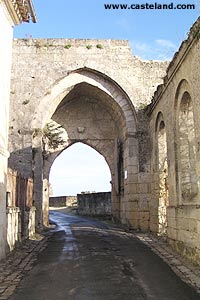

Dordogne |
Gironde |
Lot et Garonne |
Pyrénées Atlantiques |
Other
regions & other castles |
Previous months’ selections |
|
Castle of Saint Emilion |
|
|
1 - Ramparts, ditches and doors of the city
In the high part of the city, the ramparts were bordered of dry ditches dug in the sharp one of the rock: these ditches flat-bottomed measure between 5 and 10 meters of depth and up to 20 meters of width by places. Badly maintained starting from XVème century, the wall gradually will break down, it remains however several hundred meters of wall preserved very well along the "way of the ditches", in the part Is city, as along the ditches which face the collegiate church: vestiges of machicolation of XlVème century are still visible. The wall was bored of 6 doors. So some were shaven, as the "Bourgeoise door", the "Bouqueyre door" or the "door of the canons", others are still well preserved: it is the case of the
"Brunet door" which one can almost discover in his state
of origin: it leads to a stone bridge with two widenings in its
center to allow the crossing of the carts. Top of its 9.50 meters,
arched in cradle, it was to be overcome defensive elements: a hourd,
or machicolations. There remain the vestiges of the guardroom inside.
It is still upright because it did not open on an axis passing but
on the countryside from where the valley of the Dordogne is dominated
and did not have to suffer from the wars of religion. Nevertheless
it played a significant role at the time of these painful The Door Martin Saint: narrower than the Brunet door, it led to the old parish of Saint Martin de Mazerat, and he owes its name besides. One reached it by a bridge spanning the ditch. There remains in the thickness of the wall a staircase giving access to the covered way. Other doors as the "door of the Chapter" or the "Holy door Marie", now disappeared, had to be walled in 1721 when an epidemic of plague was declared. In addition to its defensive doors, ditches and machicolation, the wall was equipped with many stations of monitoring and defense. To notice, the tower of the guettor, contemporary of the construction of the ramparts. It rises with a few ten meters of the Brunet door, in direction of the Bouqueyre place from where one can see a guérite guet, called "watch tower". |
|
Castle of the month : |
Search |
For any question concerning this Web site, send a message to webmaster

 The
construction of the enclosure of the city started certainly in 1110
to be completed in 1224, the method of construction of the ramparts
is traditional: the walls make on average 1,50 m thickness and consist
of two parallel facings of stones of size filled with blocking:
mix hardcores and of mortar.
The
construction of the enclosure of the city started certainly in 1110
to be completed in 1224, the method of construction of the ramparts
is traditional: the walls make on average 1,50 m thickness and consist
of two parallel facings of stones of size filled with blocking:
mix hardcores and of mortar.  events
which marked the history of the city deeply: it is by this door
that Sully and its troops will force the entry in the city in 1580.
events
which marked the history of the city deeply: it is by this door
that Sully and its troops will force the entry in the city in 1580.
